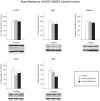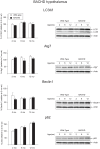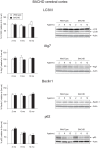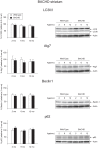Maintenance of basal levels of autophagy in Huntington's disease mouse models displaying metabolic dysfunction
- PMID: 24376631
- PMCID: PMC3869748
- DOI: 10.1371/journal.pone.0083050
Maintenance of basal levels of autophagy in Huntington's disease mouse models displaying metabolic dysfunction
Abstract
Huntington's disease (HD) is a fatal neurodegenerative disorder caused by an expanded polyglutamine repeat in the huntingtin protein. Neuropathology in the basal ganglia and in the cerebral cortex has been linked to the motor and cognitive symptoms whereas recent work has suggested that the hypothalamus might be involved in the metabolic dysfunction. Several mouse models of HD that display metabolic dysfunction have hypothalamic pathology, and expression of mutant huntingtin in the hypothalamus has been causally linked to the development of metabolic dysfunction in mice. Although the pathogenic mechanisms by which mutant huntingtin exerts its toxic functions in the HD brain are not fully known, several studies have implicated a role for the lysososomal degradation pathway of autophagy. Interestingly, changes in autophagy in the hypothalamus have been associated with the development of metabolic dysfunction in wild-type mice. We hypothesized that expression of mutant huntingtin might lead to changes in the autophagy pathway in the hypothalamus in mice with metabolic dysfunction. We therefore investigated whether there were changes in basal levels of autophagy in a mouse model expressing a fragment of 853 amino acids of mutant huntingtin selectively in the hypothalamus using a recombinant adeno-associate viral vector approach as well as in the transgenic BACHD mice. We performed qRT-PCR and Western blot to investigate the mRNA and protein expression levels of selected autophagy markers. Our results show that basal levels of autophagy are maintained in the hypothalamus despite the presence of metabolic dysfunction in both mouse models. Furthermore, although there were no major changes in autophagy in the striatum and cortex of BACHD mice, we detected modest, but significant differences in levels of some markers in mice at 12 months of age. Taken together, our results indicate that overexpression of mutant huntingtin in mice do not significantly perturb basal levels of autophagy.
Conflict of interest statement
Figures





References
-
- The Huntington’s Disease Collaborative Research Group (1993) A novel gene containing a trinucleotide repeat that is expanded and unstable on Huntington’s disease chromosomes. Cell 72: 971–983. - PubMed
-
- Ross CA, Tabrizi SJ (2011) Huntington’s disease: from molecular pathogenesis to clinical treatment. Lancet Neurol 10: 83–98. - PubMed
-
- Novak MJ, Tabrizi SJ (2011) Huntington’s disease: clinical presentation and treatment. Int Rev Neurobiol 98: 297–323. - PubMed
-
- Duff K, Paulsen JS, Beglinger LJ, Langbehn DR, Stout JC (2007) Psychiatric symptoms in Huntington’s disease before diagnosis: the predict-HD study. Biol Psychiatry 62: 1341–1346. - PubMed
Publication types
MeSH terms
Substances
LinkOut - more resources
Full Text Sources
Other Literature Sources
Medical
Molecular Biology Databases

